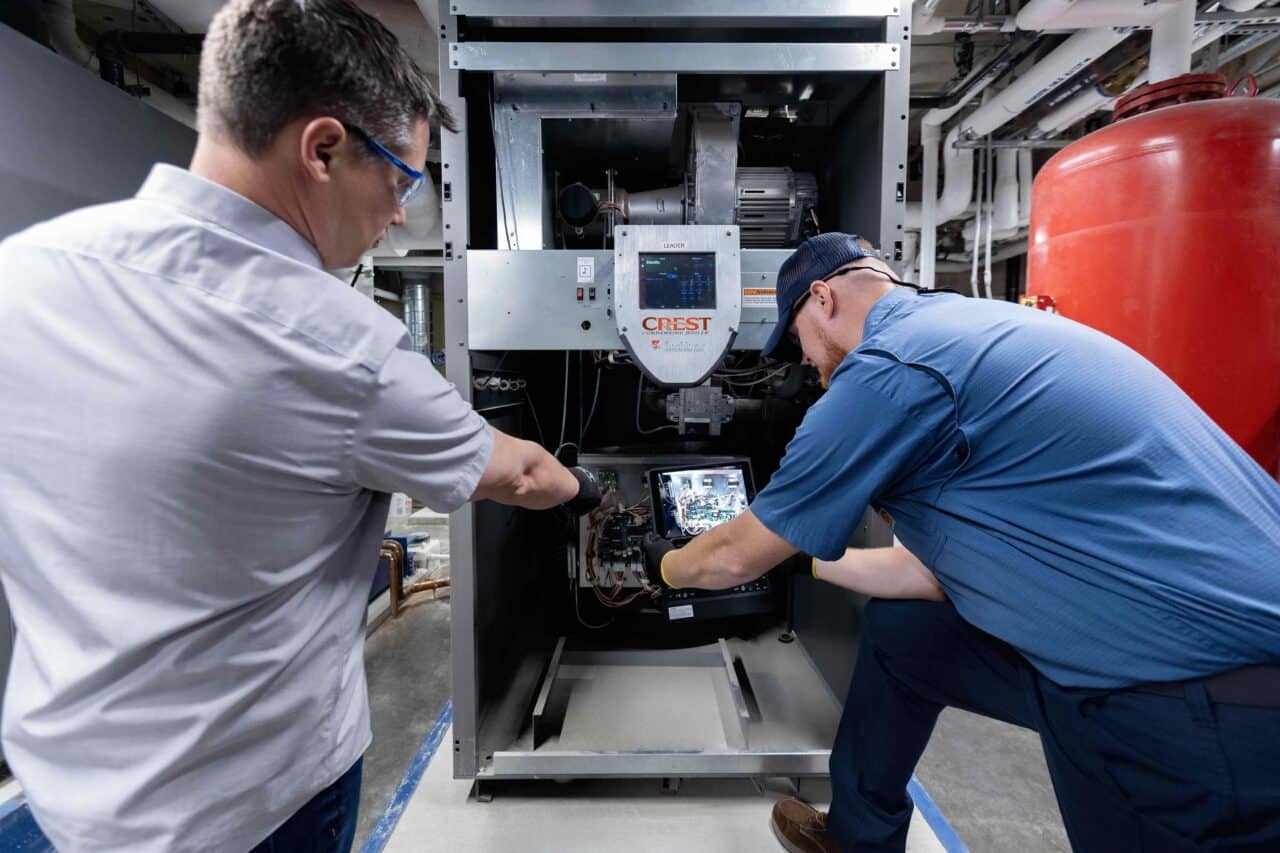In an era where technology transforms everything from coffee makers to cars, why should facility maintenance be any different? In 2024, it’s clear that embracing automation isn’t just a trend — it’s a necessity.
A workplace where HVAC systems, lighting, and safety protocols operate seamlessly is no longer a futuristic dream but a practical reality. With 45% of facility managers focused on boosting efficiency, staying on top of the latest trends keeps you ahead of the competition.
Since 1944, Lee Company has been leading the way in innovative facility management solutions across the Southeast. We understand the shift and offer creative solutions to businesses of all sizes.
Below, we’ll reveal the top trends driving automation in this sector and how they can benefit your business.
The Growing Role of Automated Facilities Maintenance
Automation is becoming a staple in every industry as the world becomes increasingly connected. In facilities management, it’s no different. Automated systems and processes are revolutionizing how we approach maintenance tasks, making them quicker, more efficient, and less prone to human error.
A recent survey of businesses shows that 63% are utilizing data analytics to boost production and efficiency. It’s clear that the way we manage our facilities is evolving. By embracing automation, businesses can cut costs and improve their facilities’ overall safety and functionality.
Key Benefits of Automated Facilities Maintenance
- Enhanced Efficiency: Automated systems can streamline maintenance schedules, reducing downtime and improving resource management.
- Predictive Maintenance: Predictive maintenance technology helps preempt equipment failures, extending the lifespan of your assets and saving costs.
- Energy Management: Automation can optimize energy usage, reducing utility costs.
- Safety and Compliance: Automated systems virtually guarantee that safety protocols, such as fire safety systems, are regularly maintained, reducing the risk of accidents and compliance issues.
- Sustainability: Automated solutions contribute to sustainable facilities management by minimizing waste and optimizing resource use.
What are the practical applications of these facilities management trends?
Consider a scenario where a commercial building uses automated systems to detect faulty equipment and schedule repairs, preventing a catastrophic breakdown. Or an energy-efficient building that reduces utility costs through automated lighting and smart heating, ventilation, and air conditioning (HVAC) controls.
At Lee Company, we’ve seen firsthand the benefits of embracing automation in facilities maintenance. In our work with Tennessee Oncology, our Smart Buildings Groups provided a technical services solution that included monitoring and alarm capabilities, delivering real-time data on indoor conditions. This ensured optimal climate control and significantly reduced operational disruptions, creating a safer and more comfortable environment for patients and medical staff.
This case study highlights how advanced monitoring and automation can enhance facility performance and reliability, aligning perfectly with the latest automated facility maintenance trends.
Overview of Trending Technologies in Facilities Maintenance
Today’s facility management landscape is increasingly defined by technologies that drive efficiency and reliability. Among these advancements, hard services are leading the way. These are critical tasks that support the physical upkeep of buildings and represent the largest and fastest-growing segment of the global facility management market:
- HVAC systems
- Lighting and electrical
- Mechanical operations
- Fire safety systems
- Building maintenance
- Gas and plumbing
Here’s an overview of the latest trends in automated facilities maintenance:
IoT Integration
Internet of Things (IoT) integration revolutionizes facility maintenance by enabling real-time systems monitoring for HVAC, lighting, security, and more. Connected devices use smart sensors to detect potential issues early, allowing immediate intervention before problems escalate.
This continuous monitoring enhances operational efficiency and is critical in predictive maintenance. This reduces downtime and optimizes the performance of critical assets.
Predictive Maintenance Technologies
Predictive maintenance takes things a step further by using AI and big data analytics to forecast equipment failures before they happen. By analyzing patterns and trends in data, this technology enables maintenance teams to perform timely interventions, preventing unexpected breakdowns.
The result is a more reliable operation, with extended equipment life and more efficient use of resources.
Drones and Robotics in Maintenance
Drones and robotics are increasingly becoming essential tools in automated facilities maintenance. Their primary applications include facility inspections, cleaning, and even repairs in hard-to-reach or hazardous areas. For example, drones can quickly survey large rooftops or difficult-to-access structures, identifying issues that might otherwise go unnoticed.
Robotics, on the other hand, can handle repetitive tasks like cleaning and minor repairs with precision and efficiency.
Key benefits of using drones and robotics include:
- Enhanced Safety: Reducing the need for human workers to enter dangerous environments.
- Increased Efficiency: Completing tasks faster than manual methods.
- Cost Savings: Minimizing labor costs and reducing the need for extensive equipment.
Computerized Maintenance Management Systems (CMMS)
Computerized Maintenance Management Systems (CMMS) are vital tools in modern facilities management, centralizing all maintenance activities for greater efficiency. CMMS systems offer features such as:
- Asset Management: Keep detailed records of equipment, ensuring regular maintenance and extending asset life.
- Work Order Tracking: Streamline assigning, tracking, and completing maintenance tasks.
- Maintenance Scheduling: Automate routine maintenance to reduce downtime and prevent unexpected breakdowns.
AR and VR Applications
Augmented Reality (AR) and Virtual Reality (VR) are making significant strides in facility maintenance by providing immersive tools for remote assistance, training, and visualization.
These technologies are particularly valuable in overcoming the skilled labor shortage, offering practical ways to onboard and train employees.
For example, Interplay Learning utilizes AR and VR to create interactive training environments that accelerate skill development. By integrating these technologies, maintenance teams can access real-time support, visualize complex tasks, and improve accuracy in their work, ultimately enhancing productivity and reducing the likelihood of errors in maintenance operations.
Automated Cleaning Solutions
Even homeowners have embraced automated cleaning technologies like Roombas, so why shouldn’t your facility? Robotic vacuum cleaners and autonomous floor scrubbers have become essential tools in modern facilities management. They work tirelessly on whatever schedule and in whatever spaces you need, without needing a coffee break. Adopting these automated cleaning solutions frees up your team to focus on more complex maintenance tasks while keeping your facility spotless.
Automated Energy Management and Sustainability
Automation is crucial in optimizing energy usage, an aspect we touched on earlier. With smart lighting systems and automated HVAC controls, facilities can significantly reduce energy waste — a critical advancement given that HVAC systems alone account for 44% of energy consumption in commercial buildings. Additionally, the issue of water waste is equally pressing, as buildings can lose up to 30% of their water through inefficiencies.
By integrating energy management automation, facilities cut utility costs and make substantial strides toward sustainability. This aligns with modern business trends that prioritize both efficiency and environmental responsibility.
Cybersecurity in Automated Maintenance
As facilities increasingly rely on automated systems for tasks like real-time monitoring, predictive maintenance, and IoT integration, the risk of cybersecurity breaches grows.
Automated facilities maintenance systems, such as IoT devices and CMMS platforms, can be vulnerable to cyber threats, such as unauthorized access, malware, and data breaches. These threats can lead to operational disruptions, safety risks, and compromised data integrity.
To combat these vulnerabilities, it’s crucial to implement strong cybersecurity measures:
- Regular software updates
- Robust encryption
- Network segmentation
- Continuous monitoring
By taking these precautions, facilities can significantly reduce cyber threats and protect automated maintenance systems. This facilitates the safety, reliability, and efficiency of your entire operation.
Practical Advice for Implementing Automated Maintenance Solutions
Any change in your workflow requires careful planning and execution. You’ll want to take your time implementing automated maintenance solutions. Along the way, you might face challenges, like resistance to change and a learning curve for new technology.
Here are some practical tips to help you successfully implement automated maintenance solutions:
Evaluate Cost vs. Benefits
Before diving in, assess the potential return on investment (ROI). Consider the long-term savings in labor, energy management automation, and reduced downtime against the upfront costs of implementing systems like CMMS or IoT integration.
Factor in the impact on capital planning. Automated maintenance solutions can extend the lifespan of critical assets, reducing early and costly replacements and helping to manage expenses more effectively.
Another consideration is the potential for enhanced compliance with regulations, which can prevent fines and further justify the investment for decision-makers.
Select the Right Technologies
Choose technology that meets your specific needs. For example, if your facility struggles with routine maintenance tasks, automated cleaning solutions or CMMS systems will be more beneficial than AR and VR training tools.
Don’t feel you need to adopt a particular technology just because others in your industry have. Do your due diligence and choose what’s best for your facility.
Training Staff
Most employees will appreciate the benefits of automation. Still, some may fear that their jobs are at risk or that they’ll have to learn new, complex technology. This can create resistance and hinder the implementation process.
Communicate the benefits clearly and have a solid training plan so that staff feels comfortable using the new systems. This will ease the transition and empower your staff to troubleshoot and manage automated maintenance systems more efficiently.
Start Small and Scale Up
You don’t have to automate all maintenance tasks at once. Start with one or two small areas where you see clear benefits and gradually expand from there as needed. This helps spread out costs and minimizes potential disruptions to your business due to any learning curve.
Monitor and Adjust
Once the dust settles, it’s essential to continuously monitor performance. Collect feedback from your team and track metrics like:
- Time savings
- Cost savings
- Energy usage
- Equipment lifespans
This data will help you make any necessary adjustments and make sure the technology is delivering its intended benefits.
Secure Your Facility’s Future with Lee Company
Unexpected equipment failures, skyrocketing energy costs, and the challenge of maintaining peak performance… These are the daily headaches that facility managers face.
We know these issues can cripple operations and strain resources. That’s why Lee Company is committed to delivering customized solutions that address these pain points directly.
Whether you’re managing a single building or an entire portfolio, our Smart Buildings Group is equipped to design and implement advanced systems that enhance your facility’s efficiency.
From installing and maintaining building automation systems (BAS) to utilizing predictive analytics and smart technologies like the LeeStat™ thermostat, we help you minimize downtime and maximize performance.
Our support doesn’t end at installation. We can keep your systems operating at their best with system start-up, building commissioning, air balance testing, and ongoing troubleshooting. Plus, our customizable Facilities Management and Maintenance Plan is perfect for businesses of all types, providing tailored support 24/7 to keep your operations running smoothly.
Keep maintenance challenges from disrupting your business! Contact Lee Company today to drive efficiency and sustainability in your facility.
Boost efficiency and cut costs with automation.
CALL US NOW AT 615.567.1000

